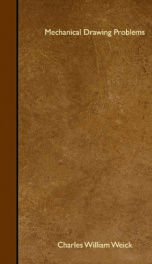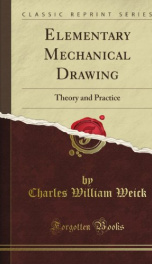mechanical drawing problems

Mechanical drawing problems - 1917 - PREFACE This volunie is a book of examples and problems for the study of mechanical drawing. It is intended to be used under the direction of a teacher, although the ambitious and painstaking student can solve many of the problems without such aid. It aims to provide a large selection of typical drawings carefully worked out as examples, each one of , which is accompanied by appropriate problems suitable for elementary and advanced work in mechanicctl drawing. Explanations and directions are, when needed, expressed in simple and direct language, and in the fewest possible words. The principles of the construction of a drawing are shown in the exdmples inthe graphic language of the draftsman. The book is divided into three parts. The First Part gives in brief outline such matter as the student will need to know before beginning work. It contains, also, a limited number of geometrical constructions which will be found helpful in solving some of the problems given. The Second Part-the practical work-is divided into four sections, namely Projections, Developments and Intersections, Isometric Drawings, and Machine Details. Nearly all the example-drawings are fully dimensioned and, where necessary, described by explanatory notes. They are not to be copied but are intended to serve as a guide to the student when making his own drawings for which directions are given in the form of problems. In each section there are many more problems than any one student can work in the amount of time which is usually allotted to the subject of mechanical drawing, and a judicious selection must necessarily be made by the teacher to meet the individual students requirement. These problems are arranged in the order of their difficulty. The problems given in the beginning of each section are not too difficult for a beginner in mechanical drawing, while those toward the end of the sections will be found suitable for advanced students. Each section begins with problems that are suitable for Junior High Schools, High Schools, and Evening Schools, and advances gradually to problems that are more difficult of solution, suitable for Vocational Schools, Trade Schools, and Colleges. In the first three sections two problems arc given with each example-drawing, and in the fourth section, three problems are given. The problems on Developments and Intersections are suitable as an introductory course for students interested in sheet metal pattern drafting. The problems on Machine Details will form a logical introduction to machine design. The Third Part of the book contains tables and general information of use to drahmen, and to which frequent reference should be made when working problems in the second and fourth sections of the Second Part...
Info about the book
Author:
Series:
Unknown
ISBN:
1581809913
Rating:
4.5/5 (4)Your rating:
0/5
Languge:
English
Users who have this book
Users who want this book
What readers are saying
What do you think? Write your own comment on this book!
write a commentif you like mechanical drawing problems try:
Other books by this author
Do you want to read a book that interests you? It’s EASY!
Create an account and send a request for reading to other users on the Webpage of the book!



